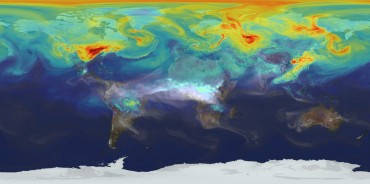It can get hot enough in the Middle Eastern sun to fry an egg outside. If you’ve spent even a small amount of time in either Abu Dhabi or any other Gulf countries in summer, you know that it’s stifling hot outside and freezing cold inside just about every building. New paint may be able to reduce cooling loads by 20 percent – at least according to research from Watergy International Group.
Watergy is working with researchers at Masdar Institute just outside of Abu Dhabi to test a new paint that is applied to rooftops.
They applied the paint, which contains titanium dioxide (a material that is used in sunscreen) to a 2, 120 square foot area of roof at the Masdar Field station. Areas of the same roof were painted grey and one area was left uncovered.
At 9:30am, when it’s already blazing hot outside, the researchers found that the areas painted white measured just 76.82 degrees Fahrenheit, whereas the uncovered areas were unbearable to walk on at 116 degrees Fahrenheit.
Peter Armstrong, associate professor of mechanical engineering at Masdar Institute, told The National that white paint makes the most sense, but that grey and black paint containing the same chemicals would also be effective if it is required for stylistic reasons.
“It is best to have white on the roof because no one can see it up there,” he said.
In addition to reducing the heat island effect associated with buildings that have soaked up a great deal of solar energy and then radiate that heat, alongside cars and other energy sources, the paint could reduce the need to cool homes with air-conditioning.
Armstrong says that uninsulated concrete villas would benefit the most from the paint.
“Villas would benefit greatly. In a typical villa the AC unit is up on the roof so when you limit the heat on the roof you improve the performance of the AC because now where the AC is, it is a lower temperature,” he told the paper. “The higher the temperature is where AC is trying to reject the heat the lower the performance.”
A hangar in Sharjah and a supermarket in Italy already benefit from the cooling paint.
The next step in Abu Dhabi, for which Watergy has signed a letter of agreement to the tune of nearly $3 million, is to test two 50,000 square meter areas in the city.
After that, the paint could be applied to a variety of surfaces in order to bring down over all temperatures – even roads.
White cars, likewise, hold more value in hot countries (link). But before you go out and buy cans of white paint, you might want to think about the climate. According to this research we covered in 2011, white paint on roof tops contributes to more global warming. The advice from 2011? Put solar panels on your roofs instead.
Aerial view of Abu Dhabi / Shutterstock





White paint on the roof have the effect of reducing the heat island effect associated with the buildings had soaked up a lot of solar energy and then radiate heat, along with cars and other energy sources, paint can reduce the need for cooling with air conditioning., this is a unique discovery and helpful to many people in the hot summer, this hot
That is a simple fix to a simple problem and it is absolutely amazing. The numbers in the article represented more like a 40 percent difference in temperature so imagine walking on a sidewalk in that brutal heat and being able to stand it! If people didn’t get the wind knocked out of their sails when they open the door to go out, they might be further inclined to not have those buildings so freezing cold inside.